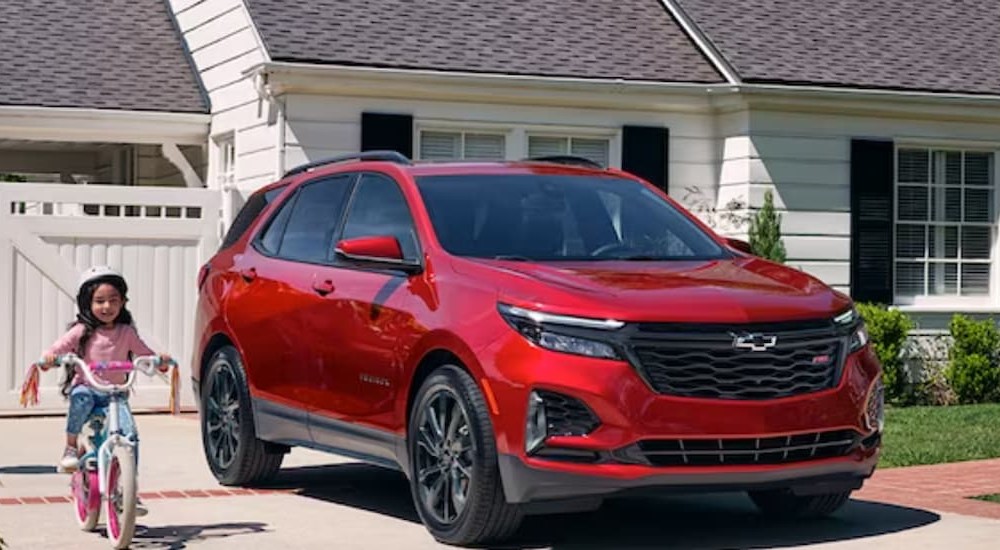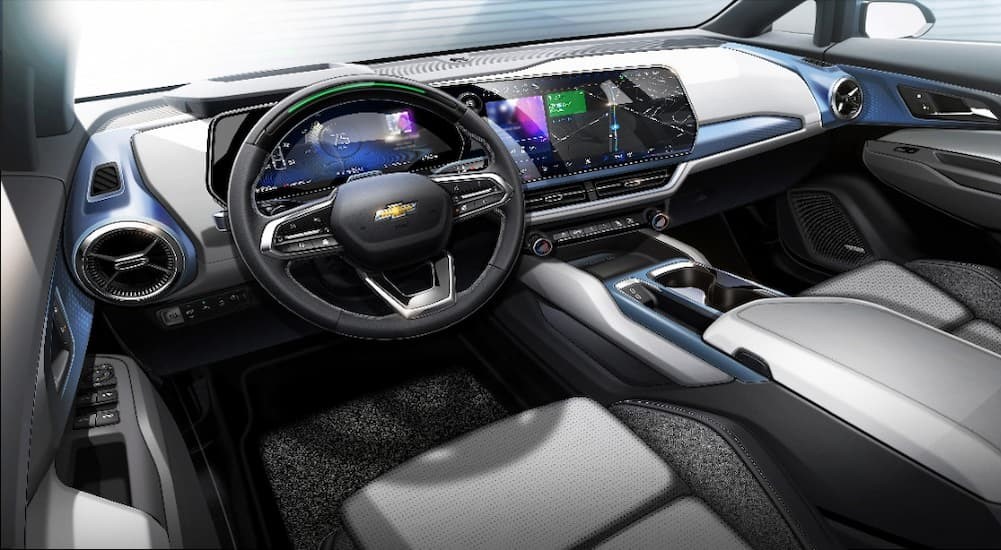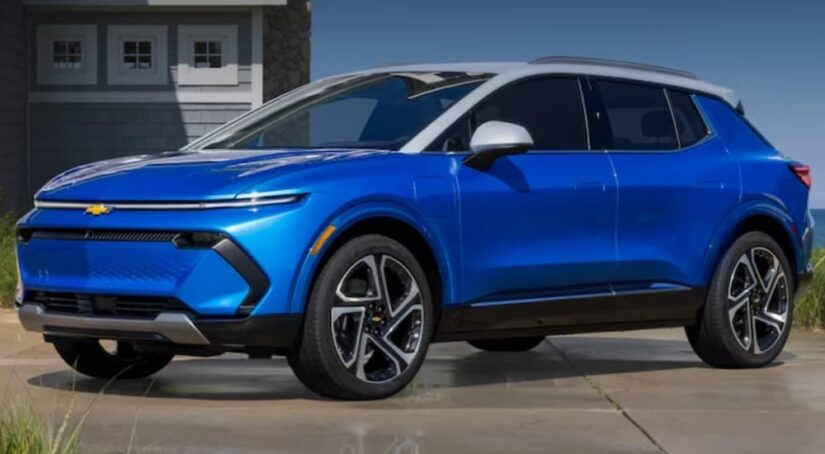There are plenty of reasons to consider switching from a traditional gas-powered vehicle to an all-electric one. Maybe you’re concerned about the impact of fossil fuels on the environment, maybe you’re sick of dealing with unpredictable gas prices, or maybe you want to get behind the wheel of the car of the future today. If you like having the extra space of an SUV but have to commute daily to work, then an electric SUV might seem particularly appealing. Whatever your reasons, buying your very first EV can be a bit overwhelming, especially if you’ve been driving for a long time and habits like stopping by the gas station or getting regular oil changes are ingrained in your mind.
One thing that can make the process easier is getting an EV based on an established, familiar nameplate; this way, you have a basic idea of how the vehicle is going to look and feel. Looking at the 2024 Chevy Equinox EV vs 2024 Chevy Equinox gas model, you’ll find that both seat five, both have around 60 cu.ft. of maximum cargo space, and both have a similar body shape—so if you already drive a traditional Equinox, then getting an Equinox EV can help you make a smooth transition to cleaner, cheaper energy.
Of course, it’s not quite as simple as switching out the gas engine for an electric motor. There are some significant differences between the two. If you’re thinking about making the switch and want to know what to expect, you’ve come to the right place. Let’s take a look at how the Equinox EV differs from its gas-powered predecessor and how those differences can affect your commute.

Fuel Costs
When you have to drive to the office almost every day, you’re going to rack up a lot of miles on the odometer—and with an SUV like the Equinox, you’ll probably be using its spacious cargo area to run errands and go on weekend adventures, too. All that driving adds up, and you’ll be buying a lot of fuel, so a gas-powered vehicle can get pretty expensive.
The 2024 Chevy Equinox with a gasoline-powered engine gets 28 MPG with FWD; according to the EPA, that’s the same score that the average 2023 vehicle gets, so it’s not bad compared to other options on the market. However, it’s also not exceptionally efficient, and gas prices can fluctuate quickly if there are problems like supply chain bottlenecks.
The 2024 Equinox EV doesn’t need gasoline at all. Electricity can come from all kinds of sources, including traditional power plants and renewable energy, so it’s more difficult for a single problem to significantly affect its price, making it a more stable monthly cost.

Charging
The difference that’s most likely to affect your day-to-day driving experience is the difference between charging an electric motor and filling the tank up with gasoline. For now, adding gas to a traditional car is significantly faster than charging the battery of an EV. With DC Fast Charging, the Equinox EV can get about 70 miles of range in just ten minutes, which isn’t very long but is definitely longer than it takes to pump an equivalent amount of fuel into a traditional Equinox.
However, you don’t have to sit around and wait for your EV to charge. For one thing, you can charge the Equinox EV at home, letting it power up overnight. You can either plug it into a regular outlet for Level 1 charging or get a 240-volt outlet installed in your garage to take advantage of faster Level 2 charging. Even that isn’t as fast as DC Fast Charging, but when you’re able to leave the car connected to a power source overnight, speed isn’t as important; if you have variable electricity pricing, then charging up overnight will also let you take advantage of the lower pricing during off-peak hours.
Depending on your workplace, you might also be able to let your Equinox EV charge up while you work since some offices have charging stations installed in their parking lots. Charging stations are also often built in the parking lots of shopping centers, so you can plug your vehicle in while you shop. You can find nearby compatible charging locations with the myChevrolet app, giving you the information you need to seamlessly transition to the EV lifestyle. A full charge gets you up to 300 miles of driving, so unless you have a truly monstrous commute, you should be able to get plenty done between charges.
Performance
Hopefully, you aren’t always stuck in bumper-to-bumper traffic during your commute. For those times when the cars on the highway are cruising along at a clip, you want to be able to speed up to match them quickly and have the power you need to accelerate fast when you want to pass slower vehicles. The traditional Equinox features a 1.5L engine that produces up to 175 hp; an Equinox RS with AWD takes about eight seconds to go from zero to sixty, which isn’t bad for a vehicle of its size.
The Equinox EV is powered by Chevy’s Ultium platform, which provides its motor with near-instant torque, thus greatly improving acceleration. With a properly equipped Equinox EV with eAWD, the powertrain produces up to 290 hp, so it packs more punch than the traditional engine. According to GM’s estimates, the Equinox EV can go from zero to sixty in just six seconds.
However, that extra horsepower doesn’t translate to extra towing capacity. While a properly-equipped traditional Equinox can tow up to 3,500 lbs, the Equinox EV offers only 1,500 lbs of towing. That should be plenty for most people who like to go on the occasional vacation with a trailer in tow or bring their boat down to the lake on the weekends, but it’s admittedly a downgrade compared to the traditional Equinox.

Interior
The user interface of the Equinox EV has a more futuristic look to it, with shiny surfaces, round air vents, a digital driver information center, and larger touchscreen options than what you’ll find on the traditional Equinox. But the layout is similar enough to the Equinox that you should be able to find the buttons you’re looking for without too much of a learning curve.
The seating area feels just as spacious as the one in the traditional Equinox, so you and your passengers can stretch out and get comfortable. However, the cargo space is slightly smaller on the Equinox EV. The 2024 Equinox features 63.9 cu.ft. of cargo volume with the rear seats folded, while the 2024 Equinox EV has 57.2 cu.ft. of space. That shouldn’t be a big deal for your average ride to the office, but it’s something worth considering if you’re in the habit of swinging by Costco on your way home.
Which One Is Right for Me?
If you have a daily commute, then switching to an efficient EV might feel like a no-brainer. But there are definitely some important factors to consider.
Before you commit to getting an EV, you should figure out where you’re going to be able to charge it. If you have a garage where you can install a Level 2 charger, or you know you’ll be able to power your vehicle up while you work, then you should be good to go. But if you live in an apartment and don’t have a place to charge up overnight—and you don’t have a good option at work either—you might not be ready to get a fully electric vehicle. If you really need the extra interior space or towing capacity that the traditional Equinox brings to the table, that could also be a dealbreaker.
Those who have a reliable place to charge up and don’t need to tow more than 1,500 lbs should find the Equinox EV to be a fantastic upgrade from the traditional Equinox. It’s a more efficient way to get to and from the office, and it’s a versatile vehicle with plenty of space for groceries or luggage. As the country’s charging infrastructure continues to grow, the Equinox EV stands to become a perfect road trip vehicle—and the more people take the plunge and switch to electric options, the closer we’ll get to a sustainable future.



